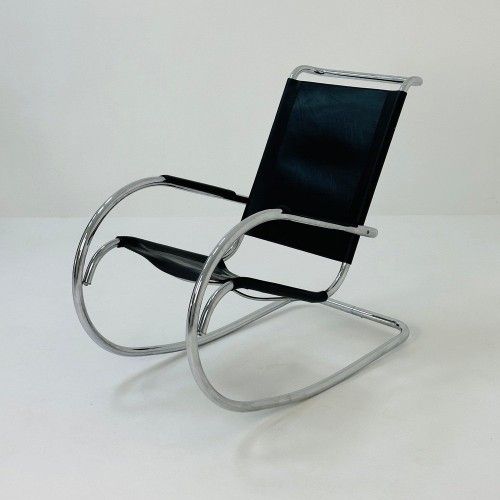FASEM BAUHAUS ROCKING CHAIR Made in Italy
$750
Last updated 2 months ago in Hayward, CA
Condition: Used (normal wear)
Listed in categories: Home & Garden - Furniture - Chairs
Chat securely on the app
Sold by

Additional images
Details
Color
Black
Material
Leather, Chrome
Item Height
30-34 in
Description
HUGE DISCOUNT PRICE!!! This designer rocking chair was made in Italy. Very elegant and comfortable vintage swing chair. The frame is made out of wide tubular chrome, while the seat and backrest are made out of thick, high-quality leather. overall in very good condition with only one sign of use. The condition is nearly brand new. There is one small nick in the leather on the left armrest, the size of a pin Needle. Other than that, there is no wear and tear. It has not been used but maybe once or twice. Mainly it has been just stored for years. The chrome is brand new and has no rust whatsoever. The leather shows no sign of age and is not worn and not sagging. It remains in beautiful condition. Because of the one minor issue on the left armrest, I'm discounting the cost of the chair. You will see this in the price as it will reflect so. Please read below for important information and history on the chair and the designer himself. Dimensions Height: 33.86 in (86 cm) Width: 22.84 in (58 cm) Depth: 39.77 in (101 cm) Seat Height: 16.93 in (43 cm) Vintage Design Mid-century Bauhaus design Rocking leather chair by Fasem Italy 1970s Designer: Mart Stam Design Period 1970 Country of Manufacture Italy Style Vintage, Bauhaus Materials Leather & Chrome Color Black Weight Range Stand Between 40kg & 80kg Dimensions length 58cm Height 92cm depth 100cm About the Creator Mart Stam Pioneering Dutch modernist architect-designer Mart Stam was a famous proponent of New Objectivity, a German cultural movement advocating for a return to unsentimental reality. He is also credited with designing the first cantilevered chair in furniture history. Born in North Holland in 1899, Martinus Adianus “Mart” Stam earned a degree in drawing from the Royal School for Advanced Studies in Amsterdam (1917-19). After graduating, he moved to Rotterdam to work as a draftsman in the architectural office of Marinus Jan Granpré Molièr whose mentoring had a lifelong impact on Stam’s career. In 1922, Stam won the right to design an urban plan concept for The Hague. Stam’s designs included roads that ran perpendicular to the beach, a novel concept that had yet to be seen. Later that year, Stam moved to Berlin and worked together with architect Max Taut and Russian avant-garde architect El Lissitzky who became a lifelong friend—on various projects. During this time, Stam began developing his signature “New Objectivity” style. Founded in the aftermath of World War I by Weimar artists Max Beckmann, Otto Dix, and George Grosz, Neue Sachlichkeit (German for “New Objectivity”) was a cross-discipline movement and aesthetic approach that was dedicated to practical engagement with the world. The Bauhaus school was founded on these sober but idealistic principles, which resulted in designs characterized by reduced forms and new materials. Turning away from expressionism, proponents of New Objectivity rejected romantic idealism in favor of realism, rationality, and order. Stam worked alongside the likes of Le Corbusier, Ludwig Mies van der Rohe, Peter Behrens, Bruno Taut, Hans Peolzig, and Walter Gropius during the landmark Die Wohnung exhibition for the Weissenhof Estate in Stuttgart in 1927. His contribution to the project included the Nr. 28 House in the White House Settlement, designing both the outside and inside. It was here that he unveiled his first set of cantilevered chairs, which would spark a whole new genre of like-minded designs. Stam’s S33 and S34 Chairs (both 1926) utilized bent tubular steel, which was thought to be the material of the future during the heyday of the modernist era. These chairs revolutionized modern furniture, as the robust nature of the tubes facilitated minimalist yet durable designs. The chair also resulted in a copyright feud between Stam and Marcel Breuer, which Stam won. Thonet put Stam’s cantilevered chair designs in production in 1932. Throughout his career, Stam held many acclaimed positions, including the editor of the avant-garde magazine ABC—Contributions to Building, the head of the Academy of Arts & Crafts in Amsterdam, and the director of the Conservatory for Applied Art in Berlin-Weißensee. After a short stint living in Amsterdam, he moved to Zurich and retired in 1966. Stam passed away later that year at the age of 86.
Additional details
Item Width
20-24 in
Brand
Fasem
Item Depth
35-39 in
Take action
Item location map
Map is approximate to keep seller’s location private.
Related searches
- Dresser
- Dining table
- Desk
- Bedroom set
- Coffee table
- Couch
- Sofa
- Tv stand
- Table
- Bed frame
- Chair
- Sectional couch
- Mirror
- Kitchen table
- Twin bed
- Bunk beds
- Bookshelves
- Futon
- Shelves